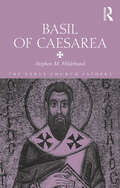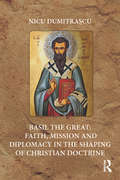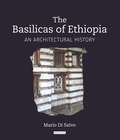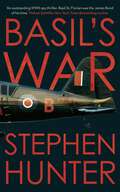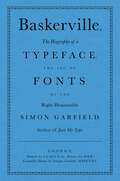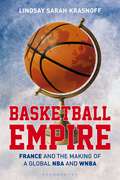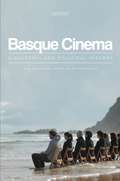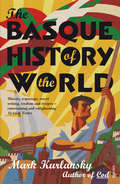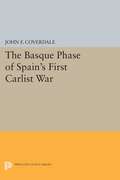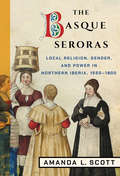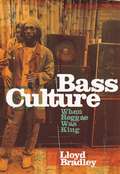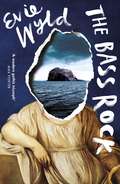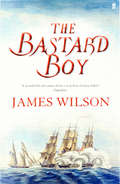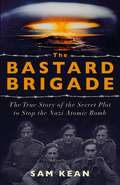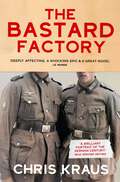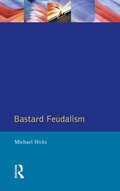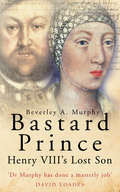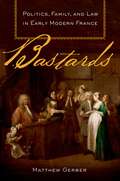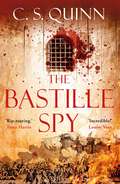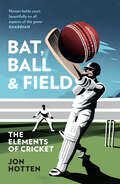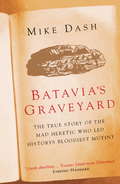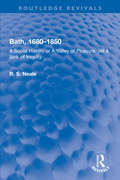- Table View
- List View
Basil of Caesarea: A Synthesis Of Greek Thought And Biblical Truth (The Early Church Fathers)
by Stephen HildebrandThis unique volume examines the life and thought of Basil of Caesarea. Stephen M. Hildebrand brings together a lengthy introduction to his life and thought with a selection of extracts from his diverse works in new translations, with each extract accompanied by an introduction and notes. This format allows students to better understand this significant figure in the Early Church by providing an accessible representative selection of his works in one concise volume, making this an invaluable resource for students of Early Christianity.
Basil the Great: Faith, Mission and Diplomacy in the Shaping of Christian Doctrine
by Nicu DumitrașcuRegarded as one of the three hierarchs or pillars of orthodoxy along with Gregory of Nazianzus and John Chrysostom, Basil is a key figure in the formative process of Christianity in the fourth century. While his role in establishing Trinitarian terminology, as well as his function in shaping monasticism, his social thought and even his contribution to the evolution of liturgical forms have been the focus of research for many years, there are few studies which centre on his political thought. Basil played a major role in the political and religious life between Cappadocia and Armenia and was a key figure in the tumultuous relationship between Church and State in Late Antiquity. He was a great religious leader and a gifted diplomat, and developed a ’special relationship’ with Emperor Valens and other high imperial officials.
Basil the Great: Faith, Mission and Diplomacy in the Shaping of Christian Doctrine
by Nicu DumitrașcuRegarded as one of the three hierarchs or pillars of orthodoxy along with Gregory of Nazianzus and John Chrysostom, Basil is a key figure in the formative process of Christianity in the fourth century. While his role in establishing Trinitarian terminology, as well as his function in shaping monasticism, his social thought and even his contribution to the evolution of liturgical forms have been the focus of research for many years, there are few studies which centre on his political thought. Basil played a major role in the political and religious life between Cappadocia and Armenia and was a key figure in the tumultuous relationship between Church and State in Late Antiquity. He was a great religious leader and a gifted diplomat, and developed a ’special relationship’ with Emperor Valens and other high imperial officials.
The Basilicas of Ethiopia: An Architectural History
by Mario di SalvoThe basilica is symbolic of the history of Christianity in Ethiopia. Aizan, the first Christian king of the Aksumite empire was responsible for the creation of the large, five-aisled church of M?ry?m ??yon, sadly destroyed in 1535, and since then many hundreds of basilicas have been built in Ethiopia, many, including the UNESCO World Heritage site of Lalibela, literally 'hewn from the rock'. In this book, architectural historian and architect Mario di Salvo considers the unique architectural features of Ethiopia's basilicas and explains how they developed over time. Featuring almost 200 colour illustrations, this book is an attractive and comprehensive guide to some of Ethiopia's most inspiring religious buildings.
Basil's War
by Stephen HunterA daredevil British agent goes behind enemy lines in this WWII-era spy thriller from Pulitzer Prize-winning critic and bestselling novelist Stephen Hunter.Basil St. Florian is an accomplished agent in the British Army, completing dangerous missions across the globe. But going undercover in Nazi-occupied France during World War II might be his toughest assignment yet. He must search for a religious manuscript that doesn't officially exist, one that genius professor Alan Turing believes may crack a code that could prevent the deaths of millions and possibly even end the war.St. Florian isn't the classic British special agent with a stiff upper lip – he is a swashbuckling, whisky-drinking cynic and thrill-seeker who resents having to leave Vivien Leigh's bed to set out on his crucial mission. Despite these proclivities, Basil's superiors know he's the best man for the job, with enough charm and quick wit to make his foes lower their guards. Action-packed and bursting with intrigue (much of which has basis in fact), Basil's War is a classic espionage thriller.Reviews for Stephen Hunter:'An outstanding WWII spy thriller' Nelson DeMille 'One of the best thriller novelists around' Washington Post 'The front rank of the thriller novelists' People
Baskerville: The Biography of a Typeface (The ABC of Fonts) (The ABC of Fonts)
by Simon GarfieldThe classic elegant English typeface, still widely used as a book text more than 250 years since its creation. Baskerville is a transitional design, poised between the first metal types and modern styles, notable for its combination of fat and thin strokes. When it was first used there was genuine concern that it would damage readers' eyes.John Baskerville was a maverick lacquer maker and printer in Birmingham, a flamboyant dresser, an important figure in the Enlightenment. Though it earned him little money, he was obsessive about both his typeface and its appearance on the page, a perfectionism culminating in his magnificent Bible. The story encompasses one of the first powerful women of the printing world, his wife Sarah Baskerville, and the many typefaces the Baskervilles inspired. And it examines why John Baskerville's body was dug up and buried many times before it was finally allowed to rest in peace.
Basketball Empire: France and the Making of a Global NBA and WNBA
by Lindsay Sarah KrasnoffThe National Basketball Association (NBA), founded over 75 years ago, is staging a 21st century takeover. Watched in 215 countries and territories worldwide, and with nearly one in three players born and trained overseas, it is no longer just about America. In this book, Lindsay Sarah Krasnoff shows how basketball's global takeover could not have happened without France, exploring its interactions with the United States and colonial legacies with francophone Africa and the Afro-Caribbean. Taking us back to the very beginnings of basketball, she shows how remnants of empire have shaped the game.Asking how and why so many French basketball players have joined the NBA and WNBA, Basketball Empire explores what this has meant for the league and the players themselves. Going behind the scenes, it follows the generations of men and women who, since 1950, have followed their passion for the game to create a basketball breeding ground. Including interviews with players, sports journalists, league directors and coaches past and present, it uncovers the transatlantic networks and complex Franco-American relations that have nurtured a mutual exchange of culture, technical skill and knowledge. These first-hand accounts, supported by media and government archives, show how these forms of sports diplomacy sowed the seeds of a basketball revolution and helped make the NBA a global cultural entity. Arguing that basketball is deeply indebted to France's colonial history and close, albeit complicated, relationship with the United States this book is about the creation of a cultural empire, and shows how sports can be the vehicle to build bridges between nations.
Basketball Empire: France and the Making of a Global NBA and WNBA
by Lindsay Sarah KrasnoffThe National Basketball Association (NBA), founded over 75 years ago, is staging a 21st century takeover. Watched in 215 countries and territories worldwide, and with nearly one in three players born and trained overseas, it is no longer just about America. In this book, Lindsay Sarah Krasnoff shows how basketball's global takeover could not have happened without France, exploring its interactions with the United States and colonial legacies with francophone Africa and the Afro-Caribbean. Taking us back to the very beginnings of basketball, she shows how remnants of empire have shaped the game.Asking how and why so many French basketball players have joined the NBA and WNBA, Basketball Empire explores what this has meant for the league and the players themselves. Going behind the scenes, it follows the generations of men and women who, since 1950, have followed their passion for the game to create a basketball breeding ground. Including interviews with players, sports journalists, league directors and coaches past and present, it uncovers the transatlantic networks and complex Franco-American relations that have nurtured a mutual exchange of culture, technical skill and knowledge. These first-hand accounts, supported by media and government archives, show how these forms of sports diplomacy sowed the seeds of a basketball revolution and helped make the NBA a global cultural entity. Arguing that basketball is deeply indebted to France's colonial history and close, albeit complicated, relationship with the United States this book is about the creation of a cultural empire, and shows how sports can be the vehicle to build bridges between nations.
Basque Cinema: A Cultural and Political History (World Cinema)
by Rob Stone Maria Pilar RodriguezCinema has always been a vital medium for articulating the Basque region's unique identity and politics. The first definitive study of Basque cinema, this book provides a systematic analysis of the key Basque films, directors and cinematic institutions. Its narrative moves from the romanticised Basque Country travelogues of Pathé to the coded oppositional aesthetics of Franco-era films; from the post-Franco 'new wave' supported by regional government funding to the boom in auteurist cinema during the 1980s and 1990s. It also charts the contemporary impact of the film institute Basque Filmoteca and television channel Euskal Telebista in producing and disseminating Basque-language films. Based on archival research, close readings of films and in-depth interviews with influential figures in the Basque film scene, this book is essential reading for world film scholars and cultural historians.
The Basque History Of The World: The Story Of A Nation
by Mark KurlanskyThe Basques are Europe's oldest people, their origins a mystery, their language related to no other on Earth, and even though few in population and from a remote and rugged corner of Spain and France, they have had a profound impact on the world. Whilst inward-looking, preserving their ancient language and customs, the Basques also struck out for new horizons, pioneers of whaling and cod fishing, leading the way in exploration of the Americas and Asia, were among the first capitalists and later led Southern Europe's industrial revolution. Mark Kurlansky, the author of the acclaimed Cod, blends human stories with economic, political, literary and culinary history to paint a fascinating picture of an intriguing people.
The Basque Phase of Spain's First Carlist War
by John F. CoverdaleThis work explores the background and first two years of the First Carlist War--a conflict that pitted conservative northern peasants against the liberal Madrid government in the largest and most sustained case of armed peasant resistance to modernization in nineteenth-century Europe.Originally published in 1984.The Princeton Legacy Library uses the latest print-on-demand technology to again make available previously out-of-print books from the distinguished backlist of Princeton University Press. These editions preserve the original texts of these important books while presenting them in durable paperback and hardcover editions. The goal of the Princeton Legacy Library is to vastly increase access to the rich scholarly heritage found in the thousands of books published by Princeton University Press since its founding in 1905.
The Basque Seroras: Local Religion, Gender, and Power in Northern Iberia, 1550–1800
by Amanda L. ScottThe Basque Seroras explores the intersections between local community, women's work, and religious reform in early modern northern Spain. Amanda L. Scott illuminates the lives of these uncloistered religious women, who took no vows and were free to leave the religious life if they chose. Their vocation afforded them considerably more autonomy and, in some ways, liberty, than nuns or wives.Scott's archival work recovers the surprising ubiquity of seroras, with every Basque parish church employing at least one. Their central position in local religious life revises how we think about the social and religious limitations placed on early modern women. By situating the seroras within the social dynamics and devotional life of their communities, The Basque Seroras reconceives of female religious life and the opportunities it could provide. It also shows how these devout laywomen were instrumental in the process of negotiated reform during the Counter-Reformation.
Bass Culture: When Reggae Was King
by Lloyd BradleyThe first major account of the history of reggae, black music journalist Lloyd Bradley describes its origins and development in Jamaica, from ska to rock-steady to dub and then to reggae itself, a local music which conquered the world. There are many extraordinary stories about characters like Prince Buster, King Tubby and Bob Marley. But this is more than a book of music history: it relates the story of reggae to the whole history of Jamaica, from colonial island to troubled independence, and Jamaicans, from Kingston to London.
The Bass Rock: ‘A rising star of British fiction’ Sunday Telegraph
by Evie Wyld'A modern gothic triumph' Max PorterThe Bass Rock has for centuries watched over the lives that pass under its shadow on the Scottish mainland. And across the centuries the fates of three women are linked: to this place, to each other.In the early 1700s, Sarah, accused of being a witch, flees for her life.In the aftermath of the Second World War, Ruth navigates a new house, a new husband and the strange waters of the local community. Six decades later, the house stands empty. Viv, mourning the death of her father, catalogues Ruth's belongings and discovers her place in the past - and perhaps a way forward.Each woman's choices are circumscribed by the men in their lives. But in sisterhood there is the hope of survival and new life...WINNER OF THE STELLA PRIZE_______________PRAISE FOR THE BASS ROCK:'Daring, heartfelt, explosive' Daisy Johnson'A vividly imagined portrait' Sunday Times'Dark, disturbing and very sophisticated' William Boyd 'Wonderfully subtle and magnificently savage' Claire Fuller
The Bastard Boy
by James WilsonNed Gudgeon wakes to find himself in a cell. He has no idea where he is or how he came to be there, but - seeing pen and paper - he begins to write. What follows is Ned's remarkable story, the story of his quest for his missing nephew, taking him from the corrupt and teeming slaving port of Bristol to the turmoil of the colonies on the brink of revolution. What is the truth behind the mystery of the bastard boy?
The Bastard Brigade: The True Story of the Renegade Scientists and Spies Who Sabotaged the Nazi Atomic Bomb
by Sam KeanScientists have always kept secrets. But rarely in history have scientific secrets been as vital as they were during World War II. In the midst of planning the Manhattan Project, the U.S. Office of Strategic Services created a secret offshoot - the Alsos Mission - meant to gather intelligence on and sabotage if necessary, scientific research by the Axis powers. What resulted was a plot worthy of the finest thriller, full of spies, sabotage, and murder. At its heart was the 'Lightning A' team, a group of intrepid soldiers, scientists, and spies - and even a famed baseball player - who were given almost free rein to get themselves embedded within the German scientific community to stop the most terrifying threat of the war: Hitler acquiring an atomic bomb of his very own.While the Manhattan Project and other feats of scientific genius continue to inspire us today, few people know about the international intrigue and double-dealing that accompanied those breakthroughs. Bastard Brigaderecounts this forgotten history, fusing a non-fiction spy thriller with some of the most incredible scientific ventures of all time.
The Bastard Factory
by Chris KrausChris Kraus’ The Bastard Factory tells the story of an entire epoch: a drama of betrayal and self-delusion spanning the years 1905 to 1975, taking us from Riga to Moscow, Berlin and Munich all the way to Tel Aviv.Hubert and Konstantin Solm are brothers, born in Riga at the beginning of the twentieth century. They will find themselves – along with their Jewish adopted sister, Ev Solm – caught up in in the maelstrom of their changing times.As the two brothers climb the rungs of society – working first for the government in Nazi Germany, then as agents for the Allied Forces, and eventually becoming spies for the young West Germany – Ev will be their constant companion, and eventually a lover to them both. The passionate love triangle that emerges will propel the characters to terrifying moral and political depths.The story of the Solms is also the story of twentieth-century Germany: the decline of an old world and the rise of a new one – under new auspices but with the same familiar protagonists.Translated from the German by Ruth Martin
Bastard Feudalism (The Medieval World)
by M.A. HicksThis major work is the most radical reinterpretation of the subject for fifty years. Hicks argues that Bastard Feudalism was far more complex - and positive in its effects - than previous accounts have suggested. A major contribution to historical debate which revolutionises our view of late medieval society.
Bastard Feudalism (The Medieval World)
by M.A. HicksThis major work is the most radical reinterpretation of the subject for fifty years. Hicks argues that Bastard Feudalism was far more complex - and positive in its effects - than previous accounts have suggested. A major contribution to historical debate which revolutionises our view of late medieval society.
Bastard Prince: Henry VIII's Lost Son
by Beverley A MurphyIt took Henry VIII 28 years, three wives, and a break with Rome before he secured a legitimate male heir. Yet he already had the illegitimate Henry Fitzroy. Fitzroy was born in 1519 after the King's affair with Elizabeth Blount. He was the only illegitimate offspring ever acknowledged by Henry VIII, and Cardinal Wolsey was even one of his Godparents. So just how close did he come to being Henry IX?
Bastards: Politics, Family, and Law in Early Modern France
by Matthew GerberChildren born out of wedlock were commonly stigmatized as "bastards" in early modern France. Deprived of inheritance, they were said to have neither kin nor kind, neither family nor nation. Why was this the case? Gentler alternatives to "bastard" existed in early modern French discourse, and many natural parents voluntarily recognized and cared for their extramarital offspring. Drawing upon a wide array of archival and published sources, Matthew Gerber has reconstructed numerous disputes over the rights and disabilities of children born out of wedlock in order to illuminate the changing legal condition and practical treatment of extramarital offspring over a period of two and half centuries. Gerber's study reveals that the exclusion of children born out of wedlock from the family was perpetually debated. In sixteenth- and seventeenth-century France, royal law courts intensified their stigmatization of extramarital offspring even as they usurped jurisdiction over marriage from ecclesiastic courts. Mindful of preserving elite lineages and dynastic succession of power, reform-minded jurists sought to exclude illegitimate children more thoroughly from the household. Adopting a strict moral tone, they referred to illegitimate children as "bastards" in an attempt to underscore their supposed degeneracy. Hostility toward extramarital offspring culminated in 1697 with the levying of a tax on illegitimate offspring. Contempt was never unanimous, however, and in the absence of a unified body of French law, law courts became vital sites for a highly contested cultural construction of family. Lawyers pleading on behalf of extramarital offspring typically referred to them as "natural children." French magistrates grew more receptive to this sympathetic discourse in the eighteenth century, partly in response to soaring rates of child abandonment. As costs of "foundling" care increasingly strained the resources of local communities and the state, some French elites began to publicly advocate a destigmatization of extramarital offspring while valorizing foundlings as "children of the state." By the time the Code Civil (1804) finally established a uniform body of French family law, the concept of bastardy had become largely archaic. With a cast of characters ranging from royal bastards to foundlings, Bastards explores the relationship between social and political change in the early modern era, offering new insight into the changing nature of early modern French law and its evolving contribution to the historical construction of both the family and the state.
The Bastille Spy: He was murdered with the executioner's tools (A Revolution Spy series)
by C. S. QuinnFrom the bestselling e-book sensation of The Thief Taker series comes a thrilling and sumptuous novel set during the early days of the French Revolution.'A rip-roaring adventure.' Tessa Harris, author of the Dr Thomas Silkstone Mysteries_________________________________'He was alive when he went in the mortuary.'1789. The Bastille is marked for destruction. Skirmishes in the city are rife and revolution is in the air. When a gruesomely murdered rebel is found in the prison morgue, a plot is suspected.English spy, Attica Morgan, is laying low after an abortive mission. So when she's given an assignment inside the Bastille, her instinct is to run. Instead, she's offered a pardon, in return for solving the mystery of the dead revolutionary; and exposing a plot that leads to Marie Antoinette.But as tensions rise to breaking point in the city, Attica quickly realises she's in a race against time. Soon there could be no Bastille to investigate.'Incredible! It's the best action adventure novel I've ever read... A fantastic achievement that has blown me away with its ingenuity, scope and breathless pace.' Louise Voss, author of the Detective Lennon series
Bat, Ball and Field: The Elements Of Cricket
by Jon HottenBat, Ball and Field combines a perfect introduction to the sport of cricket and a wonderful foray into its history. ‘Hotten is not just good, he is one of the best’ Cricketer
Batavia's Graveyard: The True Story Of The Mad Heretic Who Led History's Bloodiest Mutiny
by Mike DashThe true story of the mad heretic who led history's bloodiest mutiny - 'An adult version of LORD OF THE FLIES that is, moreover, entirely true' Evening StandardWhen the Dutch East Indiaman Batavia struck an uncharted reef off the new continent of Australia on her maiden voyage in 1629, 332 men, women and children were on board. While some headed off in a lifeboat to seek help, 250 of the survivors ended up on a tiny coral island less than half a mile long. A band of mutineers, whose motives were almost beyond comprehension, then started on a cold-blooded killing spree, leaving fewer than 80 people alive when the rescue boat arrived three months later. BATAVIA'S GRAVEYARD tells this strange story as a gripping narrative structured around three strong principal characters: Francisco Pelsaert, the cultivated but weak-willed captain; Jeronimus Cornelisz, a sinister apothecary with a terrifying personal philosophy influenced by Rosicrucianism who set himself up as the ruler of the island; and Wiebbe Hayes, the only survivor with the courage to fight Jeronimus's band. The background to these events, including the story of the Dutch East India Company, and the discovery of Australia, is richly drawn.
Bath, 1680–1850: A Social History or A Valley of Pleasure, yet a Sink of Iniquity (Routledge Revivals)
by R. S. NealeFirst published in 1981, Bath, 1680–1850 reveals the changing structure of society and its social values as shown in the expansion of the city. The book examines the lives of men and women who lived in Bath and who, as consumers and producers, transformed it from a small Cotswold town built in the vernacular style, into a uniquely spacious Palladian city devoted to the well-being and leisure activities of the wealthy. In doing so, it explores how the changes in Bath emerged in response to the needs of commerce, industry, and its growing working class, and presents the city as a microcosm of the social transformation brought about by the development of capitalism in England. Bath, 1680–1850 will appeal to those with an interest in social and cultural history.
